HM Prison and Probation Service workforce quarterly: June 2022
Updated 16 September 2022
Applies to England and Wales
Main Points
| 58,343 FTE (full time equivalent) staff in post | This is a similar number of staff in post to 30 June 2021 and a minimal change of 95 FTE (0.2%) since 31 March 2022. Of the staff in post, there were 33,893 FTE in Public Sector Prisons (PSP), 17,710 FTE staff in the Probation Service, 5,198 FTE staff in HQ and Area Services, and 1,543 FTE in the Youth Custody Service (YCS). |
| 21,725 FTE band 3-5 prison officers in post | This is a slight decrease of 318 FTE (1.4%) since 30 June 2021 and a slight decrease of 276 FTE (1.3%) prison officers compared to 31 March 2022. |
| 5,094 FTE band 2 operational support staff in post | This is no substantial change of 13 FTE (0.3%) since 30 June 2021 and no substantial change of FTE operational support staff since 31 March 2022. |
| 4,542 FTE band 4 probation officers in post | This is a slight increase of 85 FTE (1.9%) since 30 June 2021 and an increase of 204 FTE (4.7%) compared to 31 March 2022. In addition to the band 4 probation officers, there were 5,811 FTE band 3 probation services officers: a slight increase of 94 FTE (1.7%) since 30 June 2021 and a decrease of 293 FTE (4.8%) since 31 March 2022. |
| Leaving rate of 15.3% amongst band 3-5 prison officers | This is a slight increase of 0.8 percentage points compared to the year ending 31 March 2022. The overall leaving rate across HMPPS over the past 12 months stood at 13.0%, which is no substantial change (0.4 percentage points) compared to the year ending 31 March 2022. |
This publication provides details of staffing levels, staff inflows and outflows, sickness absence rates, and protected characteristics for the directly employed workforce of HMPPS. Information presented covers PSP, the Probation Service, the YCS, and HMPPS headquarters, which includes Area Services that provide direct operational support to prisons. Technical details and explanatory notes can be found in the accompanying Guide to HM Prison and Probation (HMPPS) Workforce Statistics.
Statistician’s comment
In this publication we are reporting on the HMPPS workforce as at 30 June 2022.
As at June 2022 there were 58,343 FTE staff in post, an increase of 288 FTE over June 2021.
Leaving rates fell during the COVID-19 pandemic, possibly due to increased uncertainty in the employment market. Leaving rates have now increased and are continuing the upward trend seen from March 2016 to March 2020.
HMPPS staff sickness accounted for an average of 14.4 working days per person lost for the 12 months to the end of June 2022. This is the highest in the time series and is 4.2 working days higher than the predominantly COVID-19 free year ending 31 March 2020. For the 12 months to the end of June 2022. the main reason for sickness was mental and behavioural disorders (30.3% of absences) followed by epidemic/pandemic (22.9%) of absences.
Points to note
HM Prison and Probation Service
HMPPS is focused on supporting operational delivery and the effective running of prison and probation services across the public and private sectors. HMPPS works with a number of partners to carry out the sentences given by the courts, either in custody or the community. This publication covers the reporting period up to 30 June 2022 and therefore considers in detail quarterly staffing levels and staff inflows and outflows, for HMPPS and its predecessors, since 2016.
For ease, the statistics in this publication will be referred to as those of the HMPPS workforce (i.e. staff working in HMPPS and with a contract of employment with HMPPS, excluding those on career breaks and those on secondment or loan outside of HMPPS but including staff on secondment or loan into HMPPS).
Staff employed by private sector establishments, community rehabilitation companies and other contractors are excluded.
Coronavirus (COVID-19)
Figures relating to effect of the coronavirus (COVID-19) on HMPPS staff are published alongside this edition of the bulletin as a separate annex. They are experimental statistics and include information about COVID-19 related testing, sickness and deaths of HMPPS staff.
Annex on Prison Officer recruitment diversity
As noted in previous bulletins, the annex with experimental statistics on Prison Officer and Operational Support Grade (OSG) recruitment has been moved to a six-monthly production cycle.
Annex on Probation Officer Vacancies and Trainees
As of the June 2019 publication, this annex has been added to this bulletin which presents figures on Probation Officers in post, and their required staffing level, in addition it shows the number of trainee and qualified Probation Officers.
Recent Organisational Changes
-
In June 2022 around 1,000 Approved Premises staff were moved out of HQ directorates and back into Probation Service. This reverses a move from November and December 2019, when over 1,200 NPS staff moved to the Community and Interventions directorate, part of HMPPS HQ and Areas Services. Figures for all historical periods have been revised to reflect this change.
-
The Prison region of Immigration Removal Centre and Foreign National Centre (IRCs and FNCs) group was officially disbanded at the end of March 2021 and the prisons within it were moved to be managed by their respective geographical regions:
Morton Hall - East Midlands
Huntercombe - South Central
Maidstone - Kent, Surrey and Sussex
-
In late June 2021, more than 7,000 staff from private sector Community Rehabilitation Companies (CRC) came together with probation staff already in the public sector in the new Probation Service. Records are still being updated following this change, resulting in some entries being classified as ‘unknown’ in the accompanying tables. In addition, many of the new staff had not been able to update their voluntary declarations on diversity information at the time of joining, which has led to an initial drop in recorded declaration rates for many of the indicators, as can be seen in Table 5d, of the accompanying tables.
-
From April 2021 the Probation Service has been undergoing a reorganisation, with staff moving into new Probation Delivery Units (PDUs).
-
Medway Secure Training Centre closed on 31 March 2020.
Future Plans
For future publications we are considering ways in which we can improve the bulletin, and some of the issues we may look into are as follows:
-
How to make the tables and presentation of the figures more user-friendly.
-
Whether to and how to expand the range of information provided.
If you have any particular comments or views on the above, or any other aspects you would like to be considered about this bulletin, please contact us at the address given at the end of the publication.
1. Total HMPPS staff in post
58,343 FTE staff in post (as at 30 June 2022)
This is a similar number of staff in post since 30 June 2021 and a minimal change of 95 FTE (0.2%) since 31 March 2022. Of the staff in post, there were 33,893 FTE in Public Sector Prisons (PSP), 17,710 FTE staff in the Probation Service, 5,198 FTE staff in HQ and Area Services, and 1,543 FTE in the YCS.
As at 30 June 2022, there were 58,343 FTE staff in post in HMPPS on a full time equivalent (FTE) basis (Figure 1). This includes 33,893 FTE staff in PSP (making up 58.1% of all HMPPS staff),17,710 FTE in the Probation Service (30.4% of all HMPPS staff), 5,198 FTE in HMPPS HQ and Area Services (8.9% of all HMPPS staff), and 1,543 FTE in the YCS (2.6% of all HMPPS staff).
Compared to 30 June 2021, the overall staff numbers remained broadly consistent: FTE in PSP slightly decreased by 478 (1.4%), FTE in the Probation Service slightly increased by 190 (1.1%), FTE in HQ and Area Services increased by 564 (12.2%), and FTE in the YCS slightly increased by 14 (0.9%).
As at 30 June 2022, there were 27,844 FTE (47.7% of HMPPS staff) operational prison service staff (including YCS staff). This is a slight decrease of 264 FTE staff (0.9%) compared to 30 June 2021. Non-operational roles across PSP, YCS, and HMPPS HQ accounted for 12,492 FTE staff (21.4% of HMPPS staff), which is an increase of 323 FTE (2.7%) since 30 June 2021. There were 18,007 FTE staff[footnote 1] in the Probation Service (30.9% of all HMPPS staff): a slight increase of 230 (1.3%) FTE since 30 June 2021.
Figure 1 shows a big increase in Probation Service staff in June 2021, which was due to more than 7,000 staff from private sector CRCs coming together with probation staff already in the public sector in the new Probation Service.
Figure 1: Number of HMPPS staff in post on an FTE basis, 31 March 2017 to 30 June 2022 (Source: Table 1)

1.1 Length of Service
Length of service information has been calculated for HMPPS staff from the most recent hire date. Where staff have transferred in from another government department or have transferred in through HMPPS taking over a function, length of service is calculated from entry to HMPPS.
Across HMPPS overall, 27.7% of FTE staff in post had less than 3 years’ service, which was a slight decrease from 28.7% at 30 June 2021 and no substantial change from 27.2% at 31 March 2022. 33.1% of HMPPS FTE staff in post had 10 years or more of experience, representing a decrease from 35.7% at 30 June 2021 and a slight decrease from 33.8% at 31 March 2022.
It should be noted, that the National Probation Service was created on 1 June 2014 and the service of Probation Service staff in Probation Trusts prior to the creation of the Probation Service is not included. Therefore, the figures relating to the length of service of Probation Service staff, which are included in the HMPPS overall figures, do not necessarily represent their full experience but rather the length of service from entry to HMPPS. The situation is different for the over 7000 staff who transferred from the CRCs in June 2021 and for them their service prior to their date of transfer is included.
Excluding the Probation Service, 27.3% of FTE staff in post across HMPPS had less than 3 years’ service as at 30 June 2022. This is a slight decrease of 0.7 percentage points compared to 30 June 2021. The non-Probation Service staff with 10 years’ experience or more made up 40.6% of the workforce, which is a 3.3 percentage points decrease compared to 30 June 2021.
2. Band 3-5 prison officers and band 2 operational support staff
21,725 FTE band 3-5 prison officers in post (as at 30 June 2022)
This is a slight decrease of 318 FTE (1.4%) in FTE since 30 June 2021 and a slight decrease of 276 FTE (1.3%) prison officers compared to 31 March 2022.
5,094 FTE band 2 operational support staff in post (as at 30 June 2022)
This corresponds to no substantial change of 13 FTE (0.3%) since 30 June 2021 and no substantial change of FTE operational support staff since 31 March 2022.
The key operational grades in public sector prisons are the band 3 to 5 prison officers. They consist of band 3 prison officers, band 4 officer specialists, band 4 supervising officers, and band 5 custodial managers.
Figure 2: Number of band 3-5 prison officers in post on an FTE basis, 31 March 2017 to 30 June 2022 (Source: Table 3)

The proportion of band 3-5 prison officers with less than 3 years’ service at 30 June 2022 fell to 29.9% compared to 30.8% as at 30 June 2021. The proportion of band 3-5 prison officers with between 3 to 9 years of service increased by 7.2 percentage points from 27.0% at March 2021 to 34.2% at 31 March 2022. The proportion of officers in post with 10 years or more of experience decreased by 3.8 percentage points from 39.5% at 30 June 2021 to 35.8% at 30 June 2022. This corresponds to 7,768 FTE staff with 10 years or more of experience at 30 June 2022, which is a fall of 942 FTE, or 10.8% since 30 June 2021.
The proportion of band 2 OSG FTE staff with less than 3 years’ service increased from 38.6% at 30 June 2021 to 43.4% at 30 June 2022, and the proportion of those with 10 years or more of experience decreased from 38.5% at 30 June 2021 to 33.4% at 30 June 2022.
Figure 3 shows a quarterly trend of band 3 to 5 appointments and leavers since 2016/17. Over the year to 30 June 2022, 4,060 band 3 to 5 officers were appointed (consisting of direct new recruits and existing staff who converted to a band 3 officer grade), an increase of 1,280 (46.0%) compared to 2,780 in the previous year. Looking at the quarterly figures, the headcount of new band 3 to 5 officer appointments decreased by 228 (21.9%) from 1,039 between January and March 2022 to 811 between April and June 2022 (Table 17).
The headcount of band 3 to 5 prison officers who left HMPPS in the year ending 30 June 2022 was 3,558, which is an increase of 1,264 (55.1%) compared to the year ending 30 June 2021. This is actually lower than previous quarters. Leaving rates fell during the COVID-19 pandemic, possibly due to increased uncertainty in the employment market. Leaving rates in the last year have increased and are continuing the upward trend seen from March 2016 to March 2020. Examining reasons for leaving, 74.5% of prison officers who left in the year ending 30 June 2022 resigned from their roles (up from 61.9% in the year ending 30 June 2021). Of the other prison officers who left HMPPS, 10.7% were dismissed and 6.4% retired in the year ending 30 June 2022: the proportion dismissed are down from 14.5% compared to previous year while the number retiring are similar.
Figure 3: Newly appointed band 3 to 5 prison officers and band 3 to 5 prison officer leavers, April 2016 to 30 June 2022 (Source: Table 17)
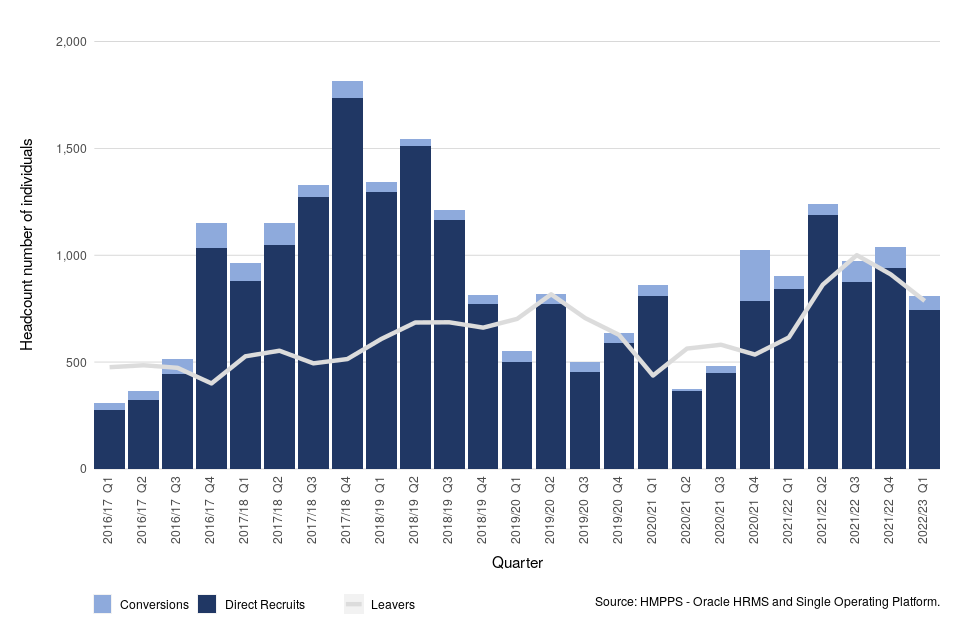
The number of band 2 OSG staff who joined HMPPS in the year ending 30 June 2022 was 1,464: an increase of 178 (13.8%) compared to the previous year ending 30 June 2021. There was a slight increase of 26 (1.8%) since the year ending 31 March 2022. The headcount number of band 2 OSG staff who left HMPPS was 1,026, which is an increase of 344 (50.4%) compared to the year ending 30 June 2021 and an increase of 44 (4.5%) compared to the year ending 31 March 2022.
Joiners and leavers are not the only movements into and out of the band 3 to 5 officer grouping. There are also typically differences in the proportion of new joiners and older officers who work part time as well as movements between grades. For these reasons, the change in FTE does not directly reflect the difference between the number of joiners and leavers. Changes such as staff switching from full time to part time have the effect of reducing the FTE of officers available as they progress through their career.
3. Probation practitioners and senior probation officers
4,542 FTE band 4 probation officers in post (as at 30 June 2022)
This figure is a slight increase of 85 FTE (1.9%) since 30 June 2021 and an increase of 204 FTE (4.7%) probation officers compared to 31 March 2022. In addition to the band 4 probation officers, there were 5,811 FTE band 3 probation services officers: a slight increase of 94 FTE (1.7%) since 30 June 2021 and a decrease of 293 FTE (4.8%) since 31 March 2022 .
Key grades in the Probation Service include band 3 probation services officers, band 4 probation officers (collectively known as probation practitioners), as well as band 5 senior probation officers. Staff who are training to be a probation officer work as a probation services officer during their training, so a proportion of the probation services officers in post will be working towards the professional probation officer qualification.
As of the June 2019 publication, an experimental statistics annex has been added to this bulletin which presents figures on Probation Officers in post, their required staffing level, in addition to the number of trainee and qualified Probation Officers.
As at 30 June 2022 there were 5,811 FTE band 3 probation services officers in post, a slight increase of 94 FTE (1.7%) over the past year and a decrease of 293 FTE (4.8%) over the quarter; 4,542 FTE band 4 probation officers, representing a slight increase of 85 FTE (1.9%) over the past year and an increase of 204 FTE (4.7%) compared to the previous quarter; and 1,261 FTE band 5 senior probation officers, showing a slight increase of 18 (1.4%) over the previous year and a slight increase of 12 (1.0%) since the last quarter (Figure 4).
Figure 4: Number of probation officers, probation services officers and senior probation officers in post on an FTE basis, 31 March 2017 to 30 June 2022 (Source: Table 3)
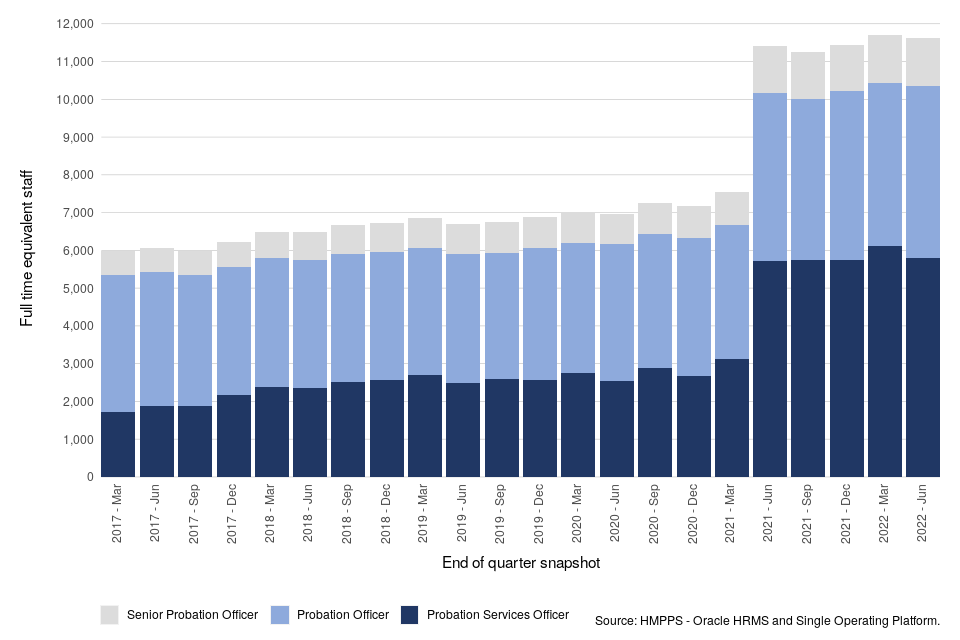
In the past year, 1,432 probation services officers were appointed, some of whom will be training to become qualified probation officers. This is an increase of 532 (59.1%) compared to the year ending 30 June 2021 and an increase of 190 (15.3%) compared to the number appointed in the year ending 31 March 2022. Within the Probation Service, there were 4,470 FTE probation officers in post, a shortfall of 1,692 FTE against the required staffing level of 6,162 FTE. There were 1,790 staff, equivalent to 1,783 FTE, undertaking the PQiP training at the end of June 2022 (please refer to the Probation recruitment annex for more details). In the past year, 835 probation services officers left the service. This is an increase of 563 (207.0%) compared to the year ending 30 June 2021 and an increase of 113 (15.7%) compared to the number who left in the year ending 31 March 2022.The number of leavers has increased considerably since June 2021, which is likely attributable to competition in the labour market
4. Joiners and Leavers
Leaving rate of 15.3% amongst band 3-5 prison officers (for the 12 months ending 30 June 2022)
This is a slight increase of 0.8 percentage points compared to the year ending 31 March 2022. The overall leaving rate across HMPPS over the past year stood at 13.0%, which is similar (0.4 percentage points) compared to the year ending 31 March 2022 of 12.6%
Over the past year, 8,351 staff joined HMPPS, which is an increase of 2,195 (35.7%) compared to the year ending 30 June 2021. These joiners consisted of 5,638 across PSP, 294 in the YCS, 2,122 in the Probation Service, and 297 in HMPPS HQ and Area Services. Compared to the year ending 30 June 2021 these numbers of joiners represent an increase of 36.0% for PSP, an increase of 57.2% for YCS, an increase of 40.3% for Probation Service, and a decrease of 4.8% for HMPPS HQ and Area Services.
There were 8,249 leavers in the year ending 30 June 2022, an increase of 3,204 (63.5%) compared to the year ending 30 June 2021. This includes 5,521 leavers from PSP (an increase of 48.2%), 219 from YCS (an increase of 59.9%), 2,114 from the Probation Service (an increase of 136.7%), and 395 from HMPPS HQ and Area Services (an increase of 36.7%).
4.1 Leaving Rates[footnote 2]
The overall HMPPS leaving rate for the year to 30 June 2022 was 13.0%, which is broadly the same as for the year to 31 March 2022 (Figure 5), which was of 12.6%, a change of 0.4% . For the year up to 31 March 2021 the increased uncertainty in the employment market following the COVID-19 pandemic may have contributed to the drop in the number of resignations during most of the year, therefore impacting on the overall reduced leaving and resignation rates. The latest leaving rates are now higher than pre-pandemic levels and are continuing the upward trend seen from March 2016 to March 2020. For band 3 to 5 prison officers, the leaving rate of 15.3% in the year ending 30 June 2022 represented a slight increase of 0.8 percentage points since the year ending 31 March 2022. The leaving rate for band 2 OSG staff was 18.9% in the year ending 30 June 2022, which is a slight increase of 0.7 percentage points compared to the year ending 31 March 2022.
Figure 5: Annual leaving rates of permanent staff in key operational grades (excluding VEDSR), from the 12 months to 31 March 2017 to the 12 months to 30 June 2022 (Source: Table 11)
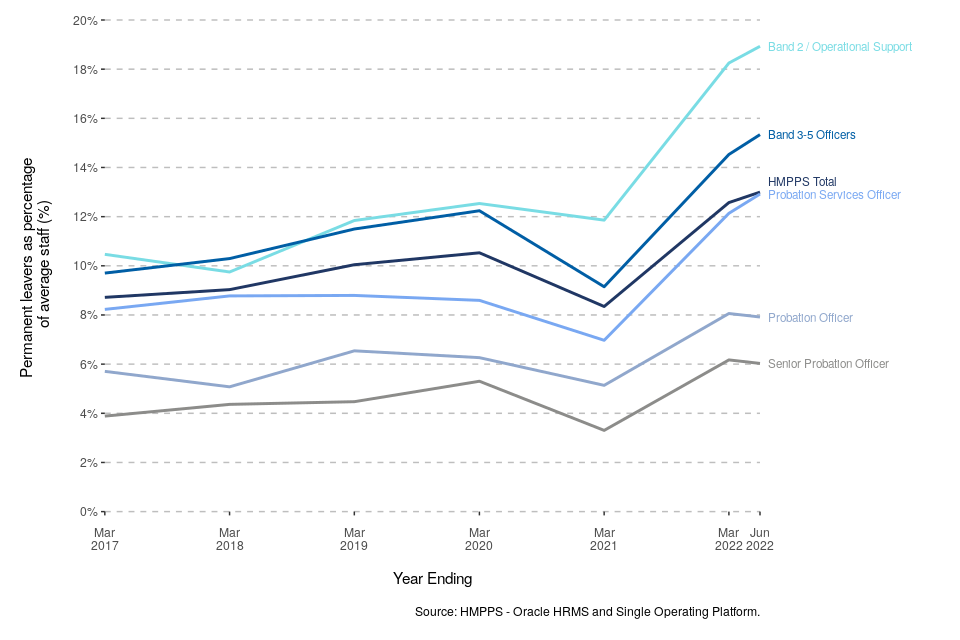
4.2 Resignation Rates[footnote 3]
The overall HMPPS resignation rate for the 12 months to 30 June 2022 was 9.0%, which is broadly the same (8.6%) as for the year to 31 March 2022 (Figure 6). For band 3-5 officers, the resignation rate was 11.5% in the year ending 30 June 2022, which is a slight increase of 0.7 percentage points since the year ending 31 March 2022. The resignation rate for OSG staff was 13.7% for the year ending 30 June 2022, which is a slight increase of 0.6 percentage points since the year ending 31 March 2022.
For Probation Service overall, the resignation rate was 7.3% for the year ending 30 June 2022. This represents no substantial change (0.4 percentage points) compared to the year ending 31 March 2022. Amongst the operational grades within the Probation Service, probation services officers had the highest resignation rate at 10.2%, (a slight increase of 0.9 percentage points) since the year ending 31 March 2022. Resignation rates for probation officers stood at 5.3% (no substantial change (0.2 percentage points) since the year ending 31 March 2022).
Figure 6: Annual resignation rates of permanent staff in key operational grades, from the 12 months to 31 March 2017 to the 12 months to 30 June 2022 (Source: Table 12)
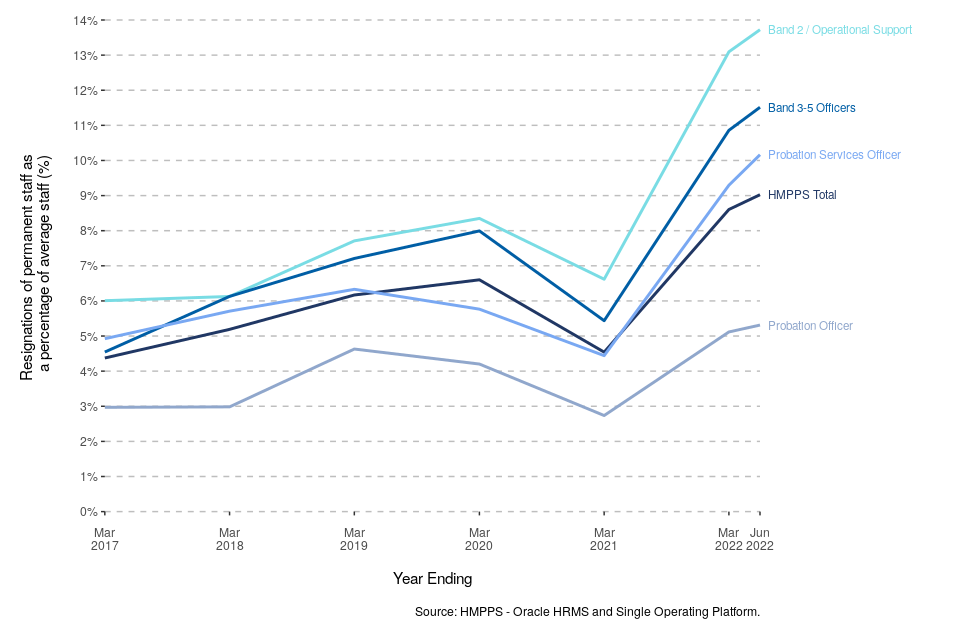
5. Sickness absence
HMPPS staff lost an average of 14.4 working days to sickness absence in the 12 months ending 30 June 2022 (including COVID sickness)
This represents an increase of 0.7 Average Working Days Lost (AWDL) compared to the year ending 31 March 2022.
Since June 2021 these sickness absence figures include COVID-19 AWDL sickness numbers, including a revision to all AWDL figures since the start of the pandemic. In addition, please see the annex with experimental statistics on COVID-19 and HMPPS staff, which includes information about staff absent due to COVID on given days.
In the year ending 30 June 2022, HMPPS staff lost an average of 14.4 working days to sickness absence. This is an increase from 13.8 average working days lost for the year ending 31 March 2022, and an increase of 3.1 days compared to the predominantly COVID-19 free year ending 31 March 2020.
YCS staff had the highest sickness absence rate at 19.3 AWDL, followed by PSP (15.9 AWDL), Probation Service (13.5 AWDL), and HQ and Area Services (6.0 AWDL) (Figure 7). Compared to the year ending 31 March 2022, these represent an increase of 1.0 days for YCS, an increase of 0.8 days for PSP, an increase of 0.6 days for Probation Service, and an increase of 0.3 days for HQ and Area Services staff.
Figure 7: Average working days lost to sickness absence, 12 months to 31 March 2017 to 12 months to 30 June 2022 (Source: Table 18)
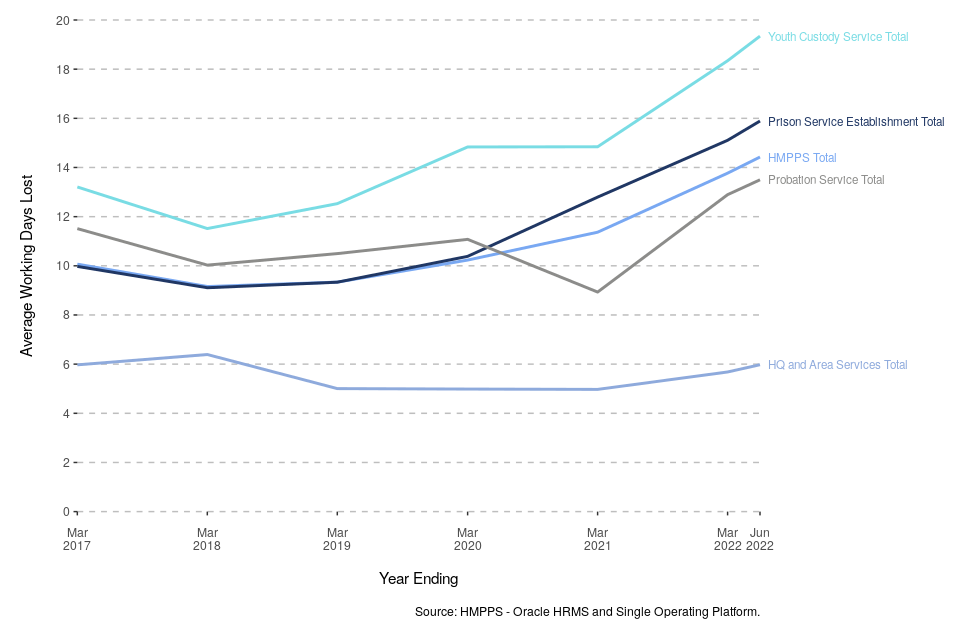
The most common category of sickness absence in terms of days lost was mental and behavioural disorders, corresponding to 30.3% of absences in the past year. This category was most prevalent for probation officers, where 50.0% of working days lost were attributed to mental and behavioural disorders.
For HMPPS overall the category that accounted for the second largest proportion of working days lost was epidemic/pandemic (22.9%). Together the top two categories accounted for 53.2% of all working days lost.
Further Information
Accompanying files
As well as this bulletin, the following products are published as part of this release:
-
A technical guide providing details of the HMPPS workforce structure as well as how the data are collected and processed. Information on the revisions policy and disclosure relevant to HMPPS staffing data is also included.
-
A set of summary tables for the latest quarter and year as well as over time.
-
A supplementary annex presenting experimental statistics on Probation Officers in post, their required staffing level, and the number of trainee and qualified Probation Officers.
-
A supplementary annex on the effect of the coronavirus (COVID-19) on HMPPS staff. They are experimental statistics and include information about COVID-19 related testing, sickness and deaths of HMPPS staff.
Official statistics
The statistics in this bulletin are classified as official statistics. The Statistics and Registration Service Act 2007 defines ‘official statistics’ as all those statistical outputs produced by the UK Statistics Authority’s executive office (the Office for National Statistics), by central Government departments and agencies, by the devolved administrations in Northern Ireland, Scotland, and Wales, and by other Crown bodies (over 200 bodies in total). The statistics in this bulletin comply with all aspects of the Code of Practice for Official Statistics. The Code encourages and supports producers of statistics to maintain their independence and to ensure adequate resourcing for statistical production. It helps producers and users of statistics by setting out the necessary principles and practices to produce statistics that are trustworthy, high quality and of public value.
Experimental Statistics
The statistics in the Recruitment annex, Probation Officer annex and the annex on the effect of the coronavirus (COVID-19) on HMPPS staff are experimental statistics. Experimental statistics are a subset of newly developed or innovative official statistics undergoing evaluation. They are developed under the guidance of the Head of Profession for Statistics (HoP) and published to involve users and stakeholders in the assessment of their suitability and quality at an early stage. Therefore, we would like to receive feedback as to how useful they are, whether a different analysis would be preferable, or any other comments about them. If you wish to send any views you may have about these experimental statistics, please use the contact details below.
Contact
Press enquiries should be directed to the Ministry of Justice press office:
Tel: 020 3334 3536
Email: newsdesk@justice.gov.uk
Other enquiries about these statistics should be directed to:
Bryce Millard
Corporate Data Sharing Lead
Data and Evidence as a Service
Ministry of Justice
10 South Colonnade
London
E14 4PH
Email: statistics.enquiries@justice.gsi.gov.uk
Next update: 17 November 2022 URL: [www.gov.uk/government/collections/national-offender-management-service-workforce-statistics
© Crown copyright Produced by the Ministry of Justice
Alternative formats are available on request from statistics.enquiries@justice.gov.uk
-
This includes staff in Probation Service grades working in other parts of HMPPS. ↩
-
Percentage of staff with a permanent contract of employment who left HMPPS, including individuals who have retired early, but excluding staff who left due to voluntary early departure schemes and redundancy (VEDSR). ↩
-
Percentage of staff with a permanent contract of employment who resigned from HMPPS. ↩
